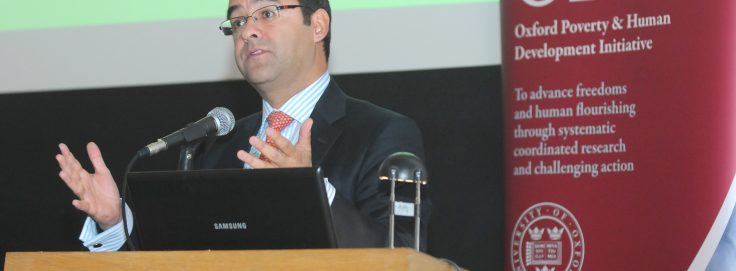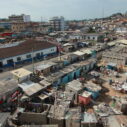
Search
Gonzalo Hernández Licona: “In Mexico, social policy has focused on multidimensional measurement”

Created in 2006, the National Council for Evaluation of Social Development Policy (CONEVAL, for its acronym in Spanish) has become the leading source for multidimensional poverty measurement and evaluation of Mexico’s social policies. The magazine ‘Revista Dimensiones’ spoke with its Executive Secretary, Gonzalo Hernández Licona[1].
Why did Mexico decide to measure multidimensional poverty?
It all began with wanting to have a clear poverty measure. Up until the year 2000, Mexico didn’t have an official poverty measurement. Then, in 2002, an income-based measure was developed by the government along with the Secretariat (Ministry) of Social Development. Thus began the Mexican adventure in measuring poverty, but only by income. After two or three years of publishing poverty information under this methodology, it turned out that poverty was, in fact, reducing.
What happened was politically interesting because the opposition in Congress was skeptical about a measurement that was provided by the government and that also affirmed that poverty was decreasing.
In Mexico, as in many other countries in Latin America, it is a common thing to be suspicious about the government’s actions. For this reason, in 2005 the Congress decided to do two things: first, to measure poverty autonomously, in order to avoid suspicion about what the government would want to be said. And second; to abide by the Social Development Law, which, by the way, was passed with the unanimous consent of all political parties and which stipulates that poverty measurement shall be multidimensional. Thus it was the Mexican Congress who decided that poverty measurement shall be done in an autonomous, independent and multidimensional manner.
Multidimensionality is the result of an effort to combine a State poverty measurement –not associated with a particular government- with the Constitution and the Social Development Law. Both stipulate that access to social rights is the guiding principle of the Mexican State’s public policies. The Constitution underlines the importance of social rights, so Congress decided that poverty measurement should also reflect access to social rights, meaning that income measurement is preserved but another six dimensions are also taken into consideration, as established within the Constitution. The measurement was not decided by an academic or a government; it was decided by the Mexican Congress.
What was the methodology selection process like?
As soon as Coneval was finally formed in 2006, we created a work plan that included inviting and having a dialogue with national and international experts working on the subject.
To create the final methodology -that is, indicators, variables, thresholds-, we made a 3 year plan. This plan had two pillars: on one side, the technical component, so we invited national and international experts to share technical ideas on how to combine the variables. On the other side, the political, governmental and congressional actors.
We started from the basis that if we wanted a poverty indicator to be used by political actors, we could not just request a technical team to deliver a formula and then instruct the politician to “use this methodology”. In Coneval we say: building a measurement and evaluation system is a political challenge with technical elements, not the other way around. Because if you only take into consideration the technical standpoint –which has to be there- but not the actors, that methodology may be perfect, but nobody is going to use it. There has to be a lot of dialogue.
In this three-year process, we spoke with researchers, international organizations, people from the World Bank and the United Nations, James Foster, Sabina Alkire, David Gordon, Chakravarty. It was an extensive dialogue that did the world a great service. Somehow, it was that exchange and conversation for several months with James Foster and Sabina Alkire that facilitated the implementation by the UNDP of a specific poverty indicator using this OPHI methodology. For us in Mexico, we benefited from the dialogue with OPHI, which helped us develop our methodology and has also served to boost multidimensional measurement all over the world, starting with the specific efforts of OPHI and then with the Multidimensional Poverty Peer Network (MPPN): it was a win-win situation.
How did you select the indicators?
Given that the six dimensions were established by the law, Coneval combined these dimensions and identified how to measure them. The standpoint that had already been politically approved in other spaces was considered. For instance, educational lagging or lack of access to education: where do we set the threshold? Literacy, primary, secondary, university education, or doctorate level? Years ago, the Congress established that education is compulsory up to the secondary level, so we followed this criterion. For those dimensions for which the National Congress had already established thresholds, we used those thresholds. This facilitated the technical work, and we gave deference to the chosen thresholds of the Congress. When there wasn’t a decision made by the Congress, we discussed it with the relevant expert bodies. It took us three years to determine the methodology due to these series of conversations with experts and the government.
How does Coneval evaluate the social policies independently?
In 2001, Congress decided for the first time in Mexican history that all subsidy programs from the federal government would have an annual evaluation. Here, mistrust was again a critical aspect. Since 1997, Congress has had a different political color from the Presidency because different political parties control it. In 2000, Congress saw that the next elections would be competitive and the real chance that a political party other than the one that had been in office for decades could win. The opposition wanted to prevent the government from using social programs for political purposes. Toward this end, they put some locks on the use of social programs, such as the requirement for external evaluations of federal social programs. External evaluations began in 2001, but it turned out that nobody knew how to conduct a good or technically adequate evaluation. Besides, each program hired its own external auditor, who later said that the program was wonderful. The same Congress that created Coneval concluded that the programs could not conduct the evaluations themselves. It was determined that Coneval should not only observe poverty but also evaluate the programs.
What it is interesting is that Coneval’s origin is based on mistrust. There was an increasing mistrust in public institutions and thus there was a need to build a trust-building space.
Nowadays Coneval’s numbers are used often. There is no doubt about the numbers’ transparency. They are not related to political preferences. There are two reasons for this: first, the information is public; any person with a computer can replicate the poverty numbers published by Coneval. The second reason is the political independence; numbers are published without taking into account the government’s political leanings, whether it is the federal, state or municipal government.
It is the same with the evaluations. There is a balance in which we report what works well and identify deficiencies.
How does the Mexican State use Coneval’s data?
Coneval has carried out a productive and permanent dialogue with governors and federal ministries, regardless of their political background, in order to understand, in the first place, the poverty measurement; and in the second place, the way to reduce poverty in accordance with Coneval’s measurement. In practice, it has become the government’s guide on social policy. The National Development Plan published in 2013 contains 14 indicators, 2 of which are from Coneval, and relate to multidimensional poverty.
Since poverty has increased from 2012 to 2014, the government has focused on reducing poverty indices, like those measured by Coneval. What is happening is that we combine two things that must always be connected from the academic or technical standpoint: a measurement instrument with political incentive from the politicians. No governor wants poverty to increase because it looks bad in political terms, and the media can criticize them severely. State-level governments are aware that they cannot reduce poverty by modifying the measure, as it used to happen with public data before, and the only way to reduce it is through effective public policy. Social policy has focused on this indicator.
What would you recommend to other countries that are in the process of designing or implementing a multidimensional measurement?
An enormous opportunity has been presented with the Sustainable Development Goals. One of these goals is to reduce poverty in all the dimensions in accordance with the national standards. With these new goals, each country shall be obliged to develop its own ways to measure poverty in a variety of dimensions. This is a plus rather than a problem. Certainly, if each country develops its own methodology, international comparison will be impossible; yet, on the other hand, we open up a huge opportunity for countries to innovate and for all of us to learn about how every country defines poverty. We can learn why poverty has a particular definition, and why a certain dimension is relevant to one country while not to another. Countries should embrace this new mandate with optimism, seriousness and innovation.
Moreover, it is a mistake to leave the poverty measurement creation process to technicians alone. It is essential to take into account the idiosyncrasy and history of each country in order to develop an indicator with a sound technical basis, but that arises from the particularities of each country.
Key information:
- National Council for the Evaluation of Social Development Policy: Decentralized public body of the Federal Public Administration with legal capacity, its own assets, and technical and management autonomy. Created in 2006.
- Website: coneval.gob.mx
- Dimensions used in its national multidimensional poverty measurement: income, educational lagging, deprivations due to access to health services, social security, housing quality and spaces, access to utilities in households, food access.
[1] Interview made on 19 May 2016.
Original in Spanish. Translated to English by Andreína Sánchez, United Nations Volunteer and Corinne Mitchell
















